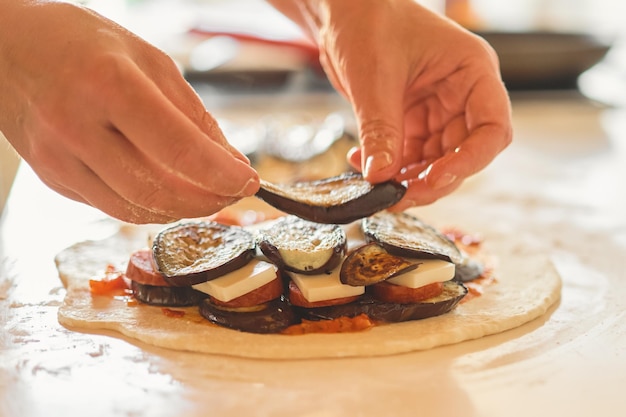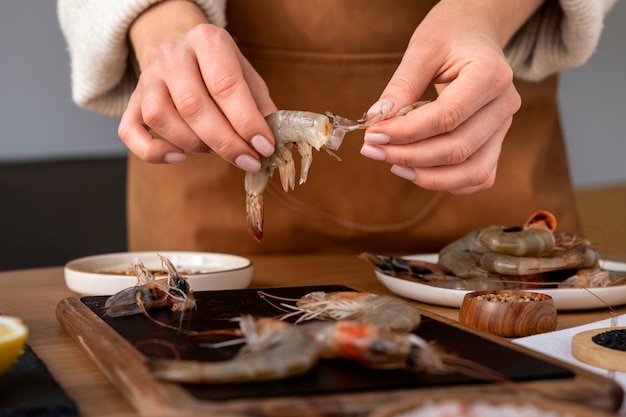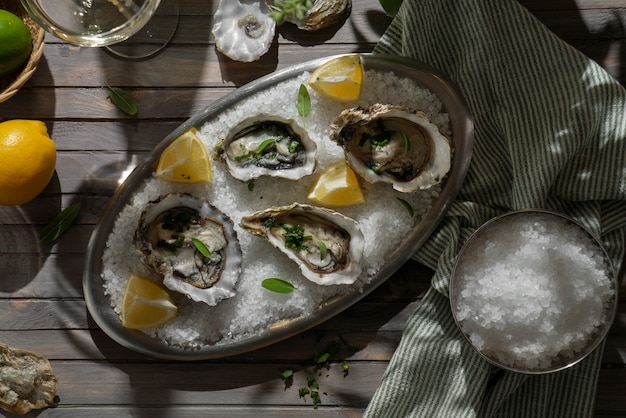Scallops, those little treasures of the sea, offer a unique culinary experience. Their delicate sweetness, tender texture, and the ability to develop a beautiful sear make them a favourite for many cooks. But mastering scallops can be a bit tricky, especially when it comes to those petite bay scallops. Overcook them even by a few seconds, and they become tough and rubbery. But nail the timing, and you'll be rewarded with a symphony of flavours and textures.
I've been on both sides of the scallop spectrum - the triumphant chef and the frustrated cook. It's a journey that's taught me the importance of precision and understanding the delicate nature of these little beauties. I'm here to share what I've learned and help you conquer the art of cooking small scallops to perfection. So, grab a pen and paper, or bookmark this page, because we're going on a culinary adventure.
(Part 1) A World of Scallop Sizes: The Charm of the Small

The first step to mastering scallops is knowing your ingredients. Scallops come in a variety of sizes, each with its own unique characteristics. Today, we're focusing on the smaller, more delicate bay scallops. These gems are often overlooked, but they offer a distinct tenderness and sweetness that makes them truly special. While their size might seem easier to manage, they require careful attention to ensure they don't get overcooked.
Imagine a delicate dance between heat and time, a delicate balance where every second counts. That's what cooking small scallops is all about.
A Scallop Size Guide: From Bay to Big
| Size | Description | Typical Diameter |
|---|---|---|
| Small (Bay Scallops) | These are the smallest scallops, often harvested from shallow waters. They have a delicate flavour and tender texture, often with a slightly sweet note. | 1/2 inch to 1 inch |
| Medium | The most common size found in supermarkets. They offer a good balance of flavour and texture, with a firmer bite. | 1 inch to 2 inches |
| Large | The largest scallops, typically from deeper waters. They have a more robust flavour and can be a bit more chewy, requiring slightly longer cooking times. | 2 inches or more |
This guide will focus on small scallops, but the principles we discuss can be adapted for larger sizes, too. Just remember to adjust cooking times accordingly.
(Part 2) Freshness Matters: The Key to Scallop Success

Let’s face it, you can't expect a delicious meal from stale scallops. The freshness of your scallops plays a crucial role in the final outcome. Imagine a sweet, clean aroma, a firm, plump texture, and a slightly translucent, almost pearlescent appearance. That's the essence of fresh scallops.
A little trick I've learned: gently press a scallop between your thumb and forefinger. If it springs back, you're good to go. If it feels mushy, it's best to pass.
Freshness Tips: A Guide to Choosing the Right Scallops
- Look for fresh, vibrant colour: Avoid scallops that show any discoloration or bruising. These are signs they might be past their prime.
- Sniff for a fresh aroma: Fresh scallops should have a sweet, slightly briny scent. If you detect a strong fishy odour, that's a sign of spoilage.
- frozen scallops? Check the packaging: If you're buying frozen scallops, choose individually frozen ones. Avoid blocks where scallops are stuck together. Look for clearly labelled packaging that indicates the freezing date and origin.
- Support local: Whenever possible, opt for fresh, locally sourced scallops. They often have a more vibrant flavour and a more delicate texture.
Freshness matters, my friends. It's the foundation for a delicious scallop dish.
(Part 3) The Art of Pan-Searing: Creating a Culinary Masterpiece

Pan-searing is my go-to method for cooking scallops. It creates that irresistible crispy crust while keeping the inside juicy and tender. It's a dance between heat and time, a culinary ballet that requires practice and a watchful eye.
pan-searing scallops can be a little intimidating, especially for beginners. But with a little guidance, anyone can achieve restaurant-quality results. Here's a breakdown of the key steps.
Pan-Searing Essentials: Your Guide to Success
- The right pan matters: A good quality pan with even heat distribution is crucial. Cast iron or stainless steel pans with a heavy base are excellent choices.
- Preheat for perfection: A scorching hot pan is essential for achieving that beautiful sear. Heat the pan over medium-high heat for a few minutes before adding the scallops.
- Fat is your friend: A thin layer of fat, like olive oil, butter, or a combination, will prevent sticking and contribute to that crispy crust.
- Don't overcrowd: Give those scallops space to breathe! Overcrowding the pan will drop the temperature, resulting in steaming instead of searing.
- Patience is key: Let the scallops rest undisturbed for a few minutes to allow a crust to form. Only flip them once, and avoid poking or prodding them while they cook.
I've found that using a combination of olive oil and butter for pan-searing gives the scallops a beautiful golden brown colour and a rich, buttery flavour. But a good quality olive oil alone will work wonders too.
(Part 4) Mastering the Timing: A Guide to Perfect Doneness
Now we get to the heart of the matter - the cooking time. It's a critical moment, and a few extra seconds can make a world of difference. Don't let those tiny scallops fool you; they cook up fast!
My advice? Keep a watchful eye on them and be ready to adjust the cooking time based on your preferences and the heat of your pan.
Cooking Times for Small Scallops (Pan-Seared): Your Guide to Doneness
| Doneness | Cooking Time per Side | internal temperature |
|---|---|---|
| Rare | 1-2 minutes | 110-115°F (43-46°C) |
| Medium-Rare | 2-3 minutes | 120-125°F (49-52°C) |
| Medium | 3-4 minutes | 130-135°F (54-57°C) |
Remember, these are guidelines. The actual cooking time will depend on the thickness of the scallops, the heat of your pan, and your personal preference. It's always a good idea to check the internal temperature with a meat thermometer. For medium-rare, the ideal temperature is around 125°F (52°C).
I prefer my scallops medium-rare. They have a lovely, slightly pink centre and a beautiful sear on the outside. But if you enjoy your scallops cooked a bit more, go for it! It's all about personal taste.
(Part 5) Beyond Pan-Searing: Exploring Other Cooking Methods
Pan-searing reigns supreme for me, but it's not the only path to scallop perfection. You can also grill, bake, or even broil them, each method adding unique flavour and texture to your dish.
Alternative Cooking Methods for Scallops: Expanding Your Culinary Repertoire
- Grilling: Grilling adds a smoky flavour and char, enhancing the scallops' inherent sweetness. Preheat your grill to medium-high heat and brush the grates with oil to prevent sticking. Cooking times are similar to pan-searing, about 2-3 minutes per side for medium-rare.
- Baking: Baking is a good hands-off method for busy cooks. Preheat your oven to 400°F (200°C) and bake the scallops for about 5-7 minutes, depending on their size and thickness. Add a touch of butter or lemon juice for extra flavour.
- Broiling: Broiling creates a nice, crispy crust. Preheat your broiler to high heat and broil the scallops for about 2-3 minutes per side, or until they are cooked through.
No matter your chosen method, keep a watchful eye on the scallops and adjust cooking times as needed. Remember, they cook fast, so vigilance is key!
(Part 6) Elevating Your Dish: The Power of a Delicious Sauce
Scallops are inherently delicious, but a well-chosen sauce can transform them into a culinary masterpiece. Imagine a creamy, buttery sauce, a bright, citrusy dressing, or a spicy, garlicky marinade - these flavours elevate the delicate sweetness of the scallops, creating a symphony of taste.
The possibilities are endless when it comes to scallop sauces. Here are a few of my personal favourites:
Scallop Sauce Ideas: Unleashing Your Culinary Creativity
- Lemon-Butter Sauce: This classic sauce is incredibly simple but pairs beautifully with scallops. Melt some butter in a pan and whisk in a squeeze of lemon juice. Season with salt and pepper to taste.
- Garlic-Herb Sauce: This fragrant sauce adds a lovely aroma to the dish. Sauté minced garlic in olive oil, then add chopped herbs like parsley, thyme, or oregano. Season with salt and pepper to taste.
- Creamy Parmesan Sauce: For a rich and decadent sauce perfect for a special occasion, combine heavy cream, grated Parmesan cheese, and a touch of white wine in a pan and simmer until thickened.
- Spicy Chili Sauce: For those who love a kick, try a spicy chili sauce. Combine chili flakes, garlic, and a touch of lime juice in a pan and simmer until thickened.
A simple lemon-butter sauce often lets the scallops shine. But if you're feeling adventurous, experiment with different flavours to find your perfect match.
(Part 7) side dish Symphony: Perfecting the Plate
Scallops are incredibly versatile, pairing well with a range of side dishes. Whether you're aiming for a light and refreshing or a rich and hearty meal, there's a perfect complement out there for every scallop lover.
Scallop Side Dish Ideas: A Culinary Harmony
- Risotto: Creamy risotto is a classic pairing for scallops. The rich, creamy texture complements the delicate sweetness of the scallops perfectly.
- Pasta: A simple pasta dish with garlic and olive oil is a light and flavourful option. You can also add a touch of lemon juice or Parmesan cheese.
- Polenta: Creamy polenta provides a hearty base for the delicate scallops, offering a textural contrast.
- Roasted Vegetables: Roasted vegetables like asparagus, broccoli, or Brussels sprouts add a touch of sweetness and colour to the dish.
- Salad: A simple green salad with a vinaigrette dressing is a light and refreshing side dish that balances the richness of the scallops.
I often enjoy a mix of roasted vegetables and a simple green salad for a balanced meal. But feel free to experiment and create your own perfect pairings.
(Part 8) From Kitchen to Table: Presentation That Makes a Difference
You've cooked your scallops to perfection, and you've chosen your side dish. Now it's time to make your culinary creation shine. Presentation is just as important as flavour, turning a delicious meal into a true feast for the eyes.
Here are some tips for making your scallop dish look as impressive as it tastes.
Scallop Presentation Tips: Elevate Your Culinary Art
- Choose a neutral-coloured plate: A white or black plate will let the colours of the scallops and sauce stand out.
- Arrange the scallops neatly: Place the scallops in a fan shape or in a single line on the plate, showcasing their beauty.
- Add a touch of greenery: A sprig of parsley or a few microgreens add a touch of freshness and colour to the plate.
- Drizzle with sauce: A simple drizzle of sauce adds a touch of elegance and flavour to the dish.
- Don't overcrowd the plate: Give the scallops and side dish plenty of room to breathe, creating a visually appealing presentation.
Remember, presentation is about creating a visual appeal that complements the taste. A well-presented dish will make your scallops even more enjoyable.
(Part 9) FAQs: Your scallop cooking Questions Answered
You've learned everything about cooking small scallops perfectly. But you still might have some questions. Here are some frequently asked questions, along with my expert answers.
FAQs
- Q: What is the best way to clean scallops?
A: Scallops don't need extensive cleaning. Simply rinse them under cold water and remove any grit or debris with your fingers or a small brush. You can also soak them in cold water for a few minutes to help remove any sand. Avoid washing them too vigorously as this can damage their delicate texture.
- Q: Can I cook scallops from frozen?
A: Yes, you can cook scallops from frozen, but they will take slightly longer. Pat them dry with paper towels and add a few extra minutes to the cooking time.
- Q: How do I know when scallops are done?
A: Scallops are done when they are opaque and firm to the touch. You can also check their internal temperature with a meat thermometer. For medium-rare, the ideal temperature is around 125°F (52°C).
- Q: What can I do with leftover scallops?
A: Leftover scallops can be added to salads, pasta dishes, or used in a stir-fry. They can also be stored in the refrigerator for up to 3 days.
- Q: What are some tips for storing fresh scallops?
A: Fresh scallops should be stored in the refrigerator for up to 2 days. Wrap them in a damp paper towel and place them in an airtight container. Avoid storing them in direct sunlight or heat.
There you have it! A comprehensive guide to cooking small scallops perfectly. With a little practice and these tips, you'll be creating mouthwatering scallop dishes in no time. So the next time you're looking for a culinary adventure, give those little gems a try. You won't be disappointed.
Everyone is watching

How to Cook Frozen Lobster Tails Perfectly: A Step-by-Step Guide
RecipesLobster. Just the word conjures up images of lavish meals, special occasions, and a taste of luxury. But let's...

Pigs in a Blanket Cooking Time: How Long to Bake for Perfect Results
RecipesAh, pigs in a blanket. Just the name conjures up images of those delightful little parcels of crispy pastry en...

Pork Fillet Cooking Time: How Long to Cook It Perfectly
RecipesPork fillet, or tenderloin as it's sometimes called, is a real favourite in our house. It's so versatile, and...

The Ultimate Guide to Cooking Delicious Frankfurters
RecipesLet's face it, we all love a good frankfurter. It's a classic, simple, and always satisfying. But let's be rea...

Wolf Meat Recipes: A Guide to Cooking Wild Game
RecipesLet's be honest, you don't see wolf meat at your local butcher shop every day. It's a bit of a wild card, but ...
